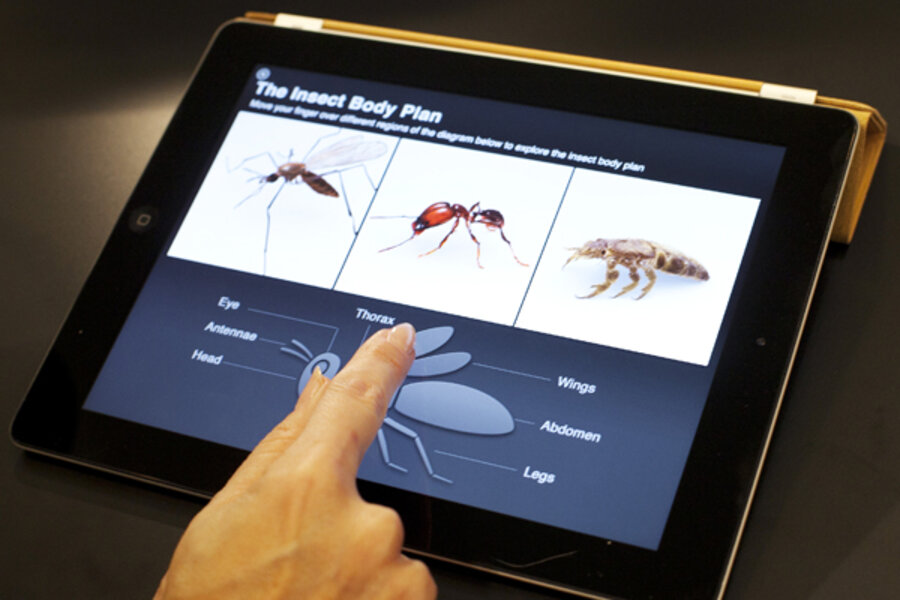Apple's new iBooks 2 fulfills one of Steve Jobs' last dreams
Apple’s event in New York showed that the iPad could eventually make paper textbooks an endangered species. And that’s just the way that former Apple chief executive Steve Jobs wanted it to be.
In his biography of Steve Jobs, author Walter Isaacson wrote about how Jobs met with media magnate Rupert Murdoch to talk about education. The books says, “Jobs agreed with Murdoch that the paper textbook business would be blown away by digital learning materials.”
“In fact, Jobs had set his sights on textbooks as the next business he wanted to transform. He believed it was an $8 billion a year industry ripe for digital destruction. He was also struck by the fact that many schools, for security reasons, don’t have lockers, so kids have to lug a heavy backpack around.”
The book quotes Jobs as saying, “The iPad would solve that.” His idea was to hire great textbook writers to create digital versions and make them a feature of the iPad.
Jobs held meetings with major publishers such as Pearson Education about partnerships.
“The process by which states certify textbooks is corrupt,” Jobs said. “But if we can make textbooks free, and they come with the iPad, they don’t have to be certified. The crappy economy at the state level will last for a decade, and we can give them an opportunity to circumvent that whole process and save money.”
iBooks 2 hands-on
Apple set its sights on education this morning when it announced a slew of new apps and services for students and teachers.
Among them was iBooks 2, an updated version of the company’s iPad e-reading app that adds support for interactive textbooks. Apple promises that iBooks 2 is a complete reinvention of the textbook as we know it. From my hands-on time with the app this morning, I’m not sure if Apple has completely obliterated the need for textbooks, but it’s certainly begun an interesting journey to do so.
The free iBooks 2 app is available today, along with a few sample textbooks on the iBookstore. I chose the E.O. Wilson Foundation’s Life on Earth, being the science nerd that I am. The app took a few minutes to download and upon first launch it played a dramatic video featuring Wilson. The video, while a bit much, makes it feel like you’re exploring an episode of Planet Earth, instead of a dry science textbook.
As the video above shows, you're presented with an attractive table of contents, which makes everything inside of the book easily accessible. Navigating the e-book was incredibly fluid, and I loved finding new interactive elements on every page. Some pages featured videos, while others featured animations and interactive 3D models. The interactivity will certainly appeal to kids, but I can also see how it can help clarify concepts for high school and university students.
I had no doubt that Apple could build a truly next-gen textbook, but I still wonder about the logistics of reinventing textbooks. Students will need an iPad to use iBooks, and the company was conspicuously silent this morning on how it will help put iPads in the hands of more kids.
iBooks Author hands-on
Apple unveiled several new apps Thursday aimed at reforming the way educators deal with textbooks, but the most interesting bit of Apple’s announcement could be the introduction of the iBooks Author app, which lets Mac users with Lion OSX create digital books for free.
I decided to take the iBooks Author app for a spin to see if the app follows Apple’s mantra of simplicity and usability, and I’m happy to report that it lives up to Apple’s typical high standards. One early report suggested Apple would launch a “Garageband for e-books” and that phrase describes this app perfectly. Like Apple’s Garageband app makes the creation of digital songs intuitive, iBooks Author makes creating an e-book supremely simple.
When you open iBooks Author for the first time, you can choose from a template that helps you get going. Between choices like Botany, Astronomy and Art History, I chose the Astronomy template because it looked the most fun. After selecting it, the app showed a left hand column that navigates between parts of the book like the cover, introductory media, table of contents and the glossary. The set up reminded me a lot of navigating through Apple’s Keynote or Microsoft’s PowerPoint, but this is dedicated to books instead of presentations.
Unlike regular books, you can embed media into your e-books like movies, 3D models, photo galleries, interactive images and Keynote presentations. Also unlike regular books, you are given the ability to preview what your book looks like on the iPad before you publish. You can plug your iPad into your Mac or connect via a Wi-Fi network and click the Preview button on the top bar.
One major downside to this software is that only Lion OS users can use the iBooks Author app. All those Mac users with Snow Leopard or an earlier version of the Mac operating system are out of luck unless they update to Lion.
Next Story: Kiwi Crate delivers crafts projects to you door, secures $5M in funding
Previous Story: We stood up to Hollywood’s bullying, here’s what we need to do next








